The NWSL Challenge Cup 2020 moved into the quarter-final stages last weekend with some big names on display and even more surprising results. The most shocking result was Portland Thorns besting North Carolina Courage in a 1-0 scoreline, however, the focus of our tactical analysis is the other quarter-final between Utah Royals and Houston Dash. The game was lively throughout in terms of duels and ultimately needed penalties to decide a winner. Their previous encounter in the tournament saw them put on one of the most exciting matches with a 3-3 draw. We’ll look at the tactics that both head coaches applied to win the game in this tactical analysis.
Lineups
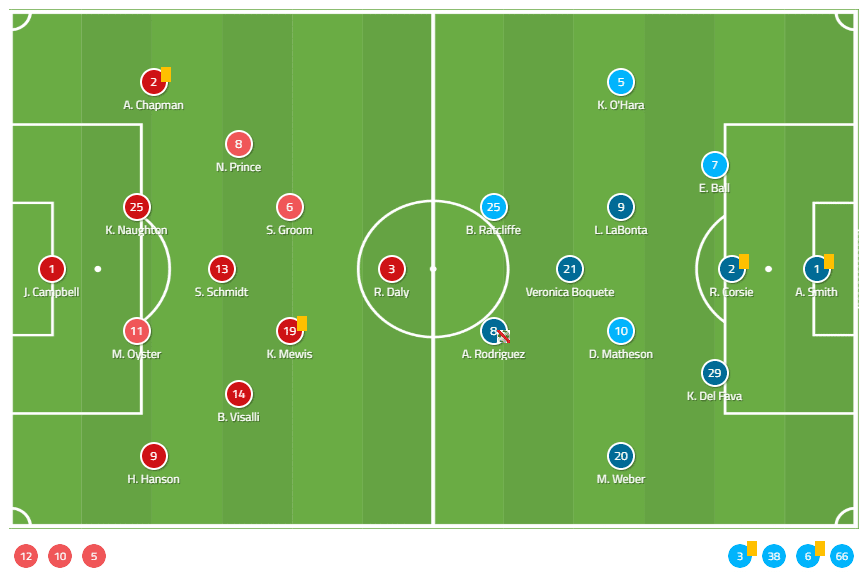
Craig Harrington continued with his three defender formation that has got the Royals so far, playing with wing-backs as their primary source of width. Kelley O’Hara made a return to the starting lineup adding experience and attacking threat down Utah Royals’ right flank. Houston Dash opted for a 4-3-2-1 system where they would once again rely on Rachel Daly as their primary outlet up front. Both teams had some good attacking players but relied on defensive stability as their core fundamentals to not give away unnecessary space. On the basis of their previous encounter in the tournament, this would have been playing on the minds of both managers.
Houston Dash: discipline & compactness
Houston Dash’s defensive structure was the core fundamental tactic they based their game plan around. Stopping Veronica Boquete and Amy Rodriguez was critical to their defensive success and Sophie Schmidt was integral to their operation. Screening the front of their back four and stopping the ‘10’ was key by not allowing Vero to have the sort of freedom she typically is able to find as the primary playmaker. If we look at Dash’s average positions map (further below) you notice Schmidt (#13) is situated in front of the two central defenders and maintained her position whilst the other two midfielders pushed up slightly. Clarkson’s ideas are similar to that of Atletico Madrid‘s Diego Simeone, specifically, the ideas he would regularly employ against more dominant sides in LaLiga and the UEFA Champions League.
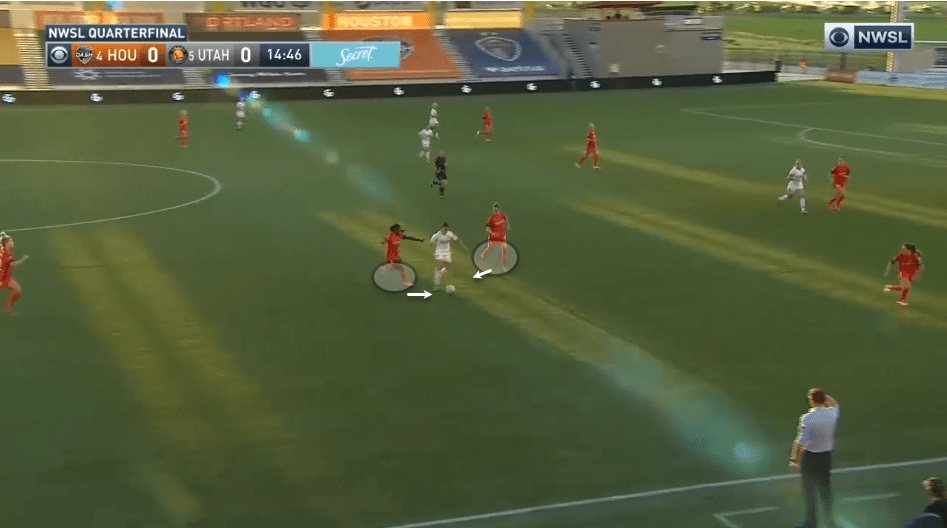
The 4-3-2-1 was a direct response to Harrington’s 3-4-1-2, especially through the middle where Utah Royals had numerical superiority. The box-to-box quality of Nichelle Prince and energy of Brianna Visalli ensured Schmidt and Dash were balanced and compact in central midfield. Dash wanted to have cover in the wide areas to stop Utah Royals from attacking. The above image shows two midfielders coming across to help Dash’s full-back in nullifying O’Hara. The two attacking midfielders in Kristie Mewis and Shea Groom were livewires whose sole purpose was to create space for Daly and press.
The duels map indicates where and how successful the teams were in overall duels across the pitch. It’s no surprise to see Dash winning most of their duels in zone 14. Schmidt engaged in nine duels against Boquete, four against Ratcliffe, and four against Diana Matheson with a total of 26 duels in 90 plus minutes making her the second-highest for Dash. Keeping the area in front of the back was critical because of the sheer number of players in this area.
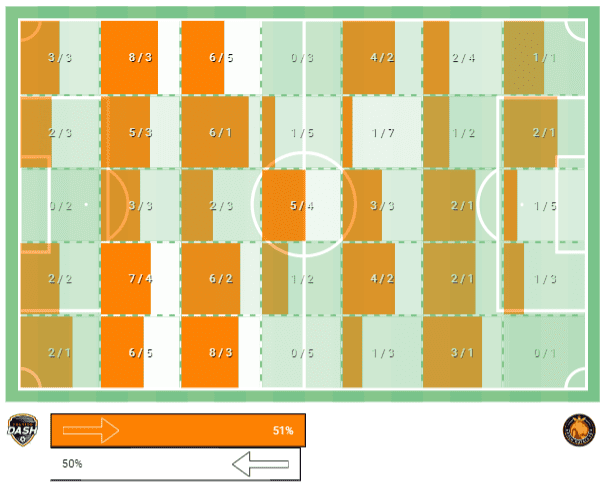
Utah Royals’ defensive structure
Utah Royals understood that they needed to shore up their defence to ensure they stopped the pace and intelligence of Rachel Daly and Groom who were instrumental throughout the tournament. This nullified the two attacks but Royals were much more resolute. Harrington pushed his defensive line further up to stop the Dash from building up in midfield where they packed numbers.
One of the reasons for this was keeping the danger woman Daly quiet. Daly was playing in between the lines as a false nine, dropping into spaces to create space for Groom and Mewis to makes runs in behind and create space in zone 14. However, this meant Daly was much more isolated against the central defenders at times when Dash would play direct to Daly with the wide players too far away from the striker to support. Royals often outnumbered the Dash attack especially when the Houston team tried to build out from the back because it allowed them time to set.
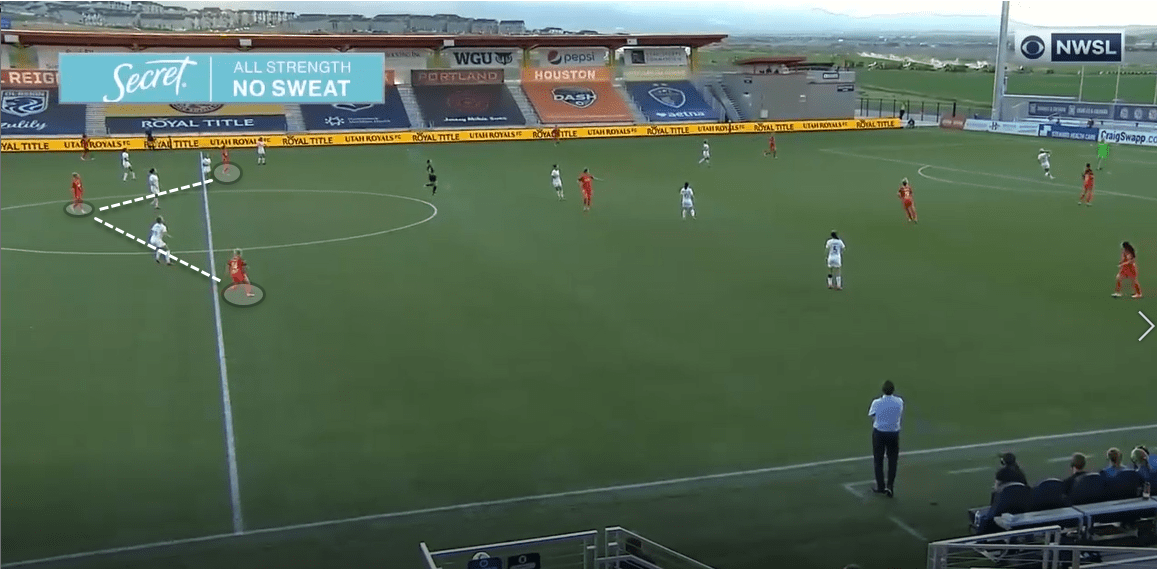
In the image above, we can see a moment in the early stages of the game where the Royals held a high line with Daly positioned between them. While two of their players are in offside positions, the gap between them and Daly up front is enough for Royals defence to mark and manage each player.
What we can also notice is the distance between the lines of defence, midfield, and attack. This allowed the Royals to create numerical superiority in their defensive and middle third, meaning they were able to control these areas through Lo’eau LaBonta, Vero, and Matheson. Ultimately, this enabled the Royals to use their pressing to put pressure on Houston Dash. Though there wasn’t enough of this, which prompted both teams to have possession in their defensive thirds and only start battling in midfield.
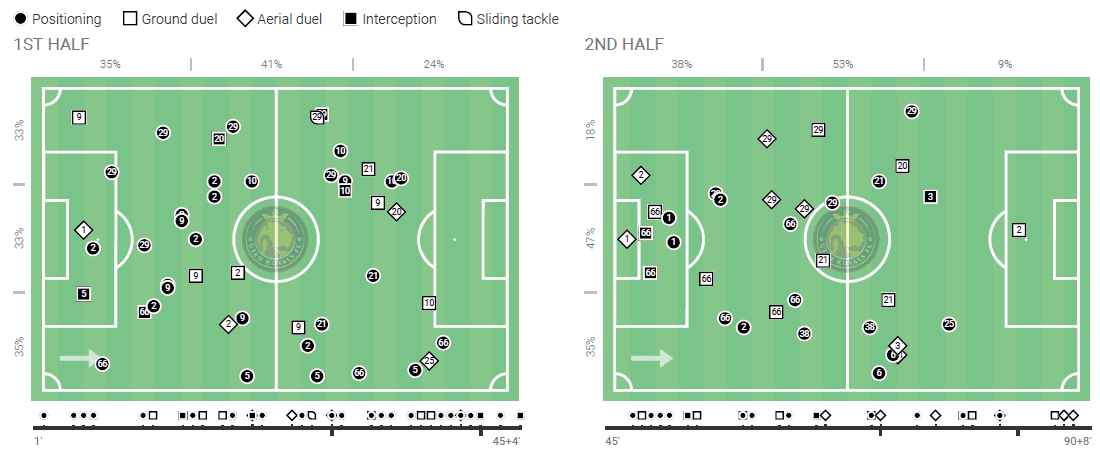
The recovery graph above indicates the areas in which Royals were able to dispossess Dash and win back the ball. We talked about the Royals wanting to control the midfield and the graph illustrates their efforts in stopping Houston Dash in getting close to their 18-yard box. The number of recoveries made across both halves were away from the box, especially in the half-spaces. The three central defenders were key to this with Rachel Corsie (14), Kate Del Flava (14), and Gunnhildur Jónsdóttir (12) making vital stops. Even LaBonta, who is primarily a forward-thinking midfielder, playing in her new defensive midfield position made eight recoveries.
Houston Dash attacking inconsistencies
James Clarkson’s Dash were wary of the threat posed by Utah Royals’ forward line and wanted to be defensively solid before committing to attacks. They played on the counter-attack leaving Daly as the lone false nine with the two 10s in Mewis and Groom just in behind playmaking. One of the Dash’s plans of action was to exploit the inevitable space in behind Utah Royals’ back line because of their high line. The Royals playing three at the back meant the wing-backs would be a major part of their attacking endeavours, however, Dash wanted to exploit the spaces in behind through Mewis, Groom, Visalli, and Prince.
Houston Dash’s attacking structure involved a lot of positional rotations with build-up geared towards getting the ball into the two ‘10s’ to play in the full-backs and wide central midfielders who would drop off into the half-spaces to ultimately give Daly clear-cut chances to score. When given the chance, the full-backs would push forward and provide true width. All of this would be derived from soaking up Royals pressure and using their high defensive line to their advantage on the counter-attack.
Theoretically, they would always have a spare player in the half-spaces through the rotations. Daly’s role as a false nine was critical as her movement in dropping off pulled players out of position. If one ‘10’ dropped to pull the defensive midfielder out of position, the overlapping central midfielder/full-back would capture the attention of the centre-back and full-back. This would leave the spare player (central midfielder or full-back) to make a late run to engage in a 1 vs 1 battle. This would subsequently give Daly a 1 or 2 vs 1 situation in the middle. Her movement in the 18-yard box would help navigate her way towards a cross. Despite this, the team struggled to find any real consistency throughout the match. The issue was Dash’s tempo was too slow for different portions for this strategy to work. They needed to play quicker in the final third to give Daly’s movement some serious threat. Any time they increased tempo and moved the ball faster in midfield, they were able to find spaces between Royals’ centre-back and wing-back.
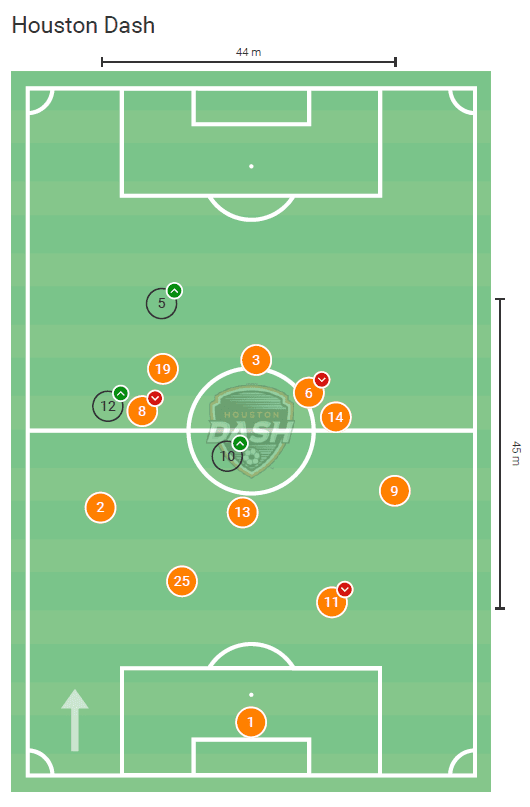
The graphic above illustrates Dash’s average position across the match and we can see Groom (#6) and Mewis (#19) both positioned either side of Daly (#3) with Visalli (#14) and Prince (#8) just outside of them. They focused on attacking down both sides but Visalli’s late runs were seemingly more effective though Prince had some success down the left too. Clarkson seemed to allow a degree of fluidity between the front three but also allowed any player that pushed forward to move around the 18-yard box without being confined to a certain area. As long as space can be found and there were enough players covering, they were allowed to roam.
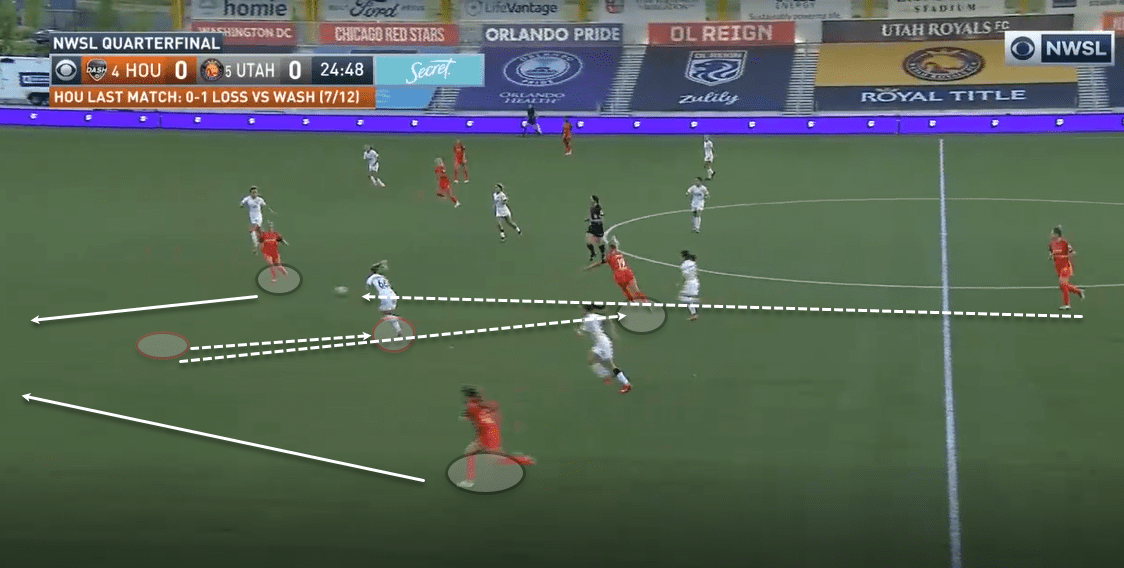
This example portrays one of the rare successful moments of attack by Dash where they were successfully able to exploit the space behind the wing-backs. In this case, the ball was switched from the right to left flank quickly with the ball played back to the centre-back. The quick progressive pass was intended for Mewis with her dropping deep pulling Jónsdóttir away with her creating space for Allysha Chapman.
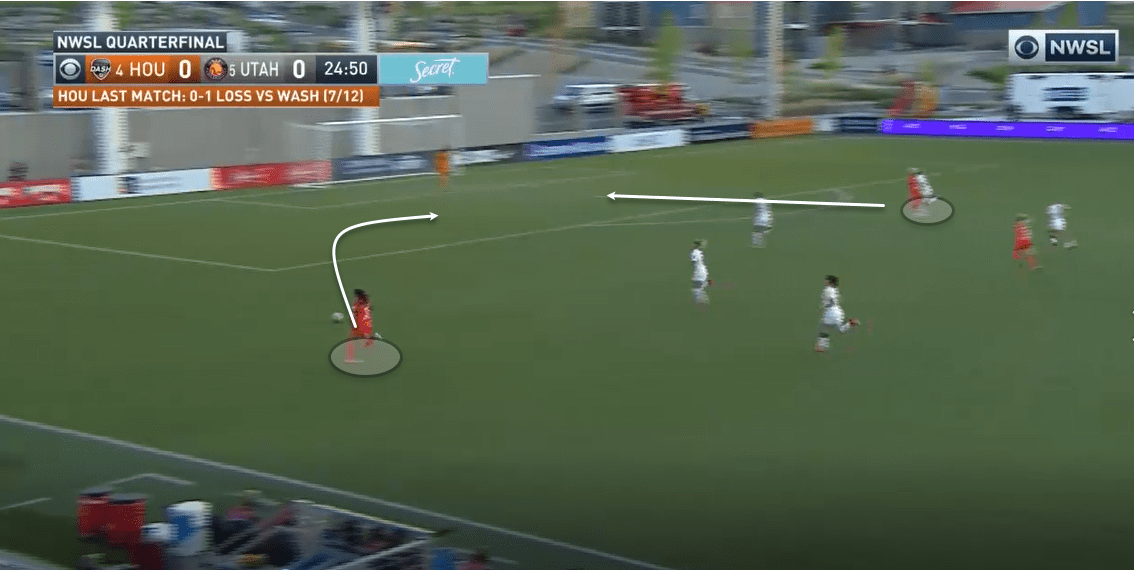
The decoy run allowed the pass to reach Visalli whose first-time pass into the path of Chapman opened up the pitch for Houston Dash. From here, Chapman had O’Hara and Jónsdóttir scrambling back leaving Daly in a 1 vs 1 battle in the middle. The tactics were correct but the lack of fluidity and urgency in midfield thwarted them from creating more attacks of this type. The overall wing play was not the best from both sides where it needed a bit more quality in terms of their accuracy and choice of a final pass. It was a theme for both teams throughout the 90 minutes where the game would be played in a stop-start fashion. A high number of fouls and constant stoppages didn’t let the game flow.
The second half saw an increase in tempo from Houston Dash which coincided with the link-up play between Daly, Groom, and Visalli improve, though chances were hard to come by. The three attackers combined better to find spaces in between the Royals defence as they grew tired but kept them at bay which can be seen through the expected goals of the second half of 0.09. The number indicates the ineffectiveness of Dash’s attack to create meaningful scoring chances with the Royals midfield and defence holding firm. The introduction of Aminata Diallo gave Royals fresh legs in midfield which helped in keeping the Dash attack in check.
Utah Royals’ central focus
Part of the tactics of using a three-man formation is to be able to unleash the wing-backs and use width to create a method of attack. Utah Royals had O’Hara back in the side which gave them a boost going forward on the right side, but ultimately they failed to get any real penetration down the flanks. Both O’Hara and Mallory Weber pushed down the wings and produced a high volume of attacks, however, their combined xG was much lower than the chances created centrally. This prompted a change at half time with O’Hara coming off.
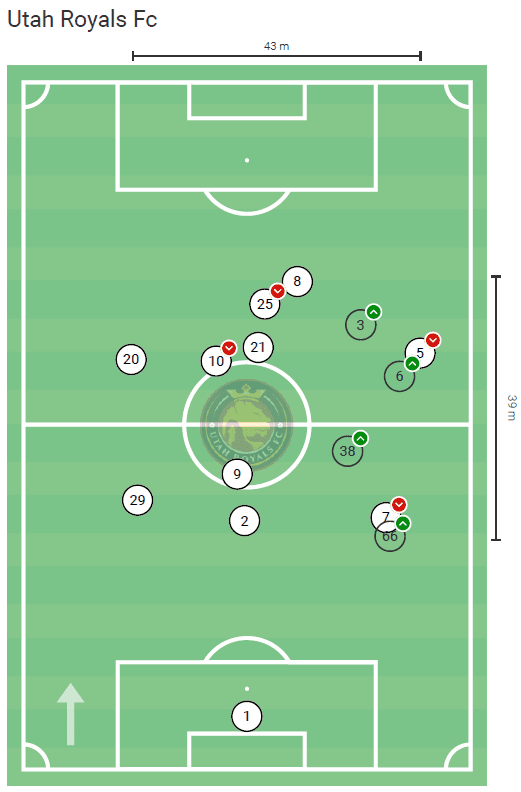
Harrington wanted to utilise the passing range of LaBonta and play long passes into the half-spaces for Rodriguez and Brittany Ratcliffe. LaBonta attempted five long passes, six progressive passes, and eight passes to the final third from her deeper position. Her average pass length was 17.8 metres was the second-highest for the team which showed LaBonta was playing medium to long passes rather than going short. The team yielded an overall xG of 0.89 which was higher than Houston’s 0.78. If we split this by half Royals had 0.35 in the first half and 0.54 in the second. So how did Royals improve offensively in the second half?
The answer lies in the setup in both halves. The first half saw Vero play deeper with Matheson pushing up higher, which limited Vero’s creativity from midfield against a mid to low block rather than her usual place behind Rodriguez. Ratcliffe dropped off at times and played just in and around Rodriguez leaving the striker to play as a lone forward but Vero’s vision in the area is unparalleled. Harrington’s decision to introduce Diallo for Matheson allowed Utah Royals to change their midfield setup. LaBonta was able to push forward slightly to utilise her passing range which also pushed Vero up into a more natural ‘10’ position. The two wing-backs played slightly narrow and helped condense the half and central spaces. These changes Dash tighten up in the middle allowing Weber and O’Hara to move outside and pick up Vero and LaBonta’s long passes just as the image below shows.
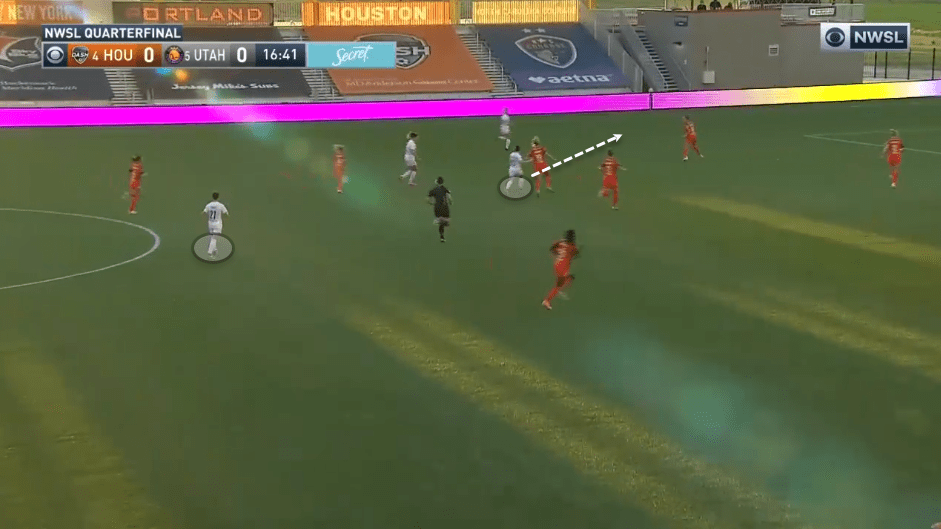
The above image is of Vero in the first half where she stayed deeper though possession was in front of her playing a more deep-lying playmaking role with Matheson taking it forward. We can see Dash putting numbers behind the ball with their central midfielders tracking back.
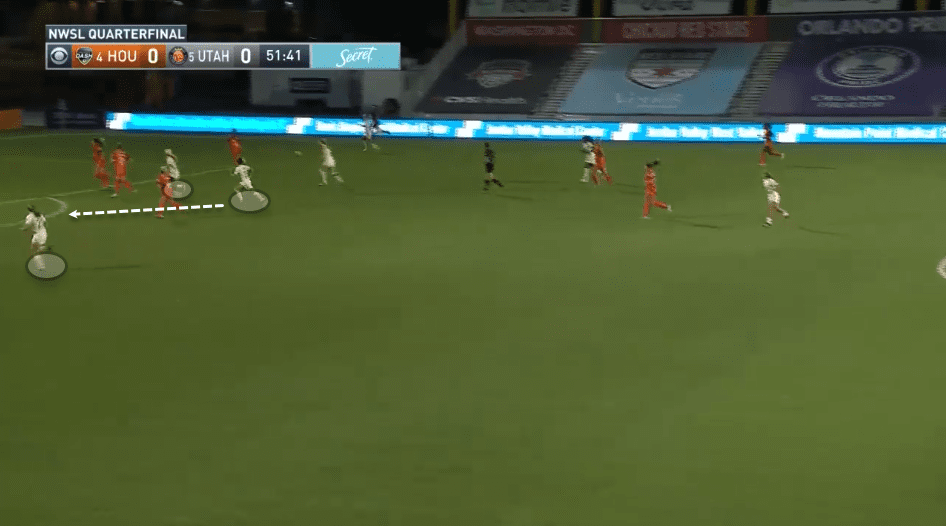
Here we can see Vero playing much higher in the second half making more forward runs playing a more attacking role joining Rodriguez and Ratcliffe in the box. Vero’s vision and directness gave the Royals attack more penetration and creativity from a dangerous area.
Final remarks
Overall, this analysis has shown that both teams were looking to nullify the other’s attacking threat by opting for a strong defensive structure. While it was a cagey game with no real flow to the game, it was a good display of disciplined tactical defending which will benefit both teams going forward. While the Dash can score goals with the threat of Daly, they also know they have the discipline and defensive astuteness to shut out opposition if need be. Harrington will be disappointed going out in this fashion giving the quality of chances his side created but will learn from his first few matches in charge. Clarkson and Dash now face a daunting task of facing the team that beat the favourites in Portland Thorns.






Comments